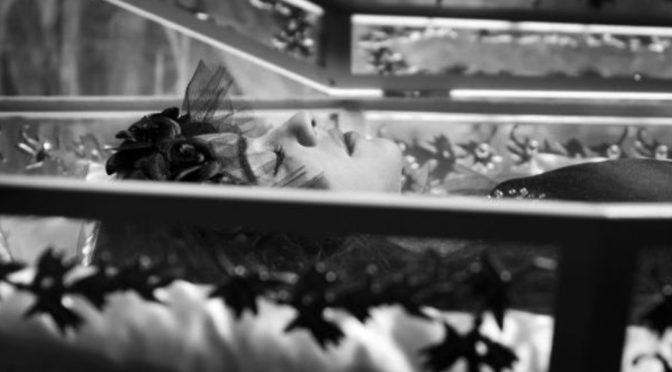![]() Pablo Berger’s gently comic, tragic melodrama BLANCANIEVES brings together the best of two cinematic waves sweeping international screens in recent years: the silent, black and white film revival sparked by the success of THE ARTIST, and a plethora of films revisiting the Brothers Grimm fairytales.
Pablo Berger’s gently comic, tragic melodrama BLANCANIEVES brings together the best of two cinematic waves sweeping international screens in recent years: the silent, black and white film revival sparked by the success of THE ARTIST, and a plethora of films revisiting the Brothers Grimm fairytales.
A far cry from the Hollywood glitz of adaptations MIRROR MIRROR and SNOW WHITE AND THE HUNTSMAN, Berger transposes the classic tale of Snow White onto 1920s Spain where it pulsates to the rhythm of castanets, the swish of flamenco skirts and bullfighters’ capes. This concrete cultural context, unlike its mythical or fantasy counterparts, provokes deeper reflection on the reinforcement of gender stereotypes by fairytales in European culture. The familiarity of the story coupled with Alfonso de Vilallonga’s varied, masterful score draws the audience in so much it is easy to forget there is no diegetic sound.
This concrete cultural context, unlike its mythical or fantasy counterparts, provokes deeper reflection on the reinforcement of gender stereotypes by fairytales in European culture.
The plot incorporates playful references to a number of other Grimm fairytales whilst adapting the story’s motifs to add humour and cultural context. The King is a wealthy, widowed bullfighter paralysed after an accident in the ring. The huntsman is the Evil Stepmother’s submissive and the dwarfs are travelling bullfighters. Maribel Verdú gives a stunning performance as the tyrannical, ferocious stepmother, a glamorous Bernarda Alba. Blancanieves herself is braver than her traditional fairytale character, as she momentarily transgresses machista culture by stepping into the bullring. Yet the greatest departure from the traditional tale comes in the film’s tragic final close-up of a single tear rolling down the cheek of the comatose heroine trapped in a glass coffin, the prize act in a travelling freak show.
Gender emerges as the focal point of a critique of Spanish machista society through the manipulation of the traditional fairytale ending.
Gender emerges as the focal point of a critique of Spanish machista society through the manipulation of the traditional fairytale ending. Blancanieves transgresses gender stereotypes when she steps into the bullring and this glimmer of female autonomy is reinforced by the absence of a knight in shining armour. Yet, our heroine ends her days ensnared in her own body, a body turned object of amusement for anyone willing to spare a few coins for a kiss. Berger (whether by intention or not) portrays on screen the perpetual challenges facing the perception of femininity in Spain, and Western culture which, in the words of Elizabeth Bronfen still ‘uses art to dream the death of beautiful women’.
Of all the recent Snow White adaptations, BLANCANIEVES undoubtedly breaks away from the traditional tale in the most creative ways. The film forces us to question the meaning of traditional fairytale motifs and how they imprint on and reflect gender relations in society.


May the fairytale continue to re-invent itself!
Great movie, worth seeing.
But specifically the comments about “gender and femininity” in the critic above sound to me like if they were from a different movie, not the one I have seen. Talking about stereotypes, the writer of the review should check that out in himself / herself. It reads like 70’s academic crap. And I am a Spanish gay man.
Thanks for the update. God forbid somebody should try and analyse something. I’ll remember to call you up next time I want the precious nugget of “Great movie, worth seeing”
Art, cinema, theatre and literature are not just entertainment ‘great movie, worth seeing’, they are also an indication or a reflection on society’s inequalities, its preoccupations. This is especially true in cinema where a film is not the sole vision of a director but a collective project. The beauty of cinema is that it suggests different things to different people. It provokes thought and opens discussion. I wonder if anyone else can appreciate the significance of Snow White’s ‘death’ at the end of the film in a culture in which every year around 70-75 women are killed as a result of domestic violence. Or the significance of the ‘silencing’ of our protagonist when 50% of victims fail to testify against the men that abuse them.